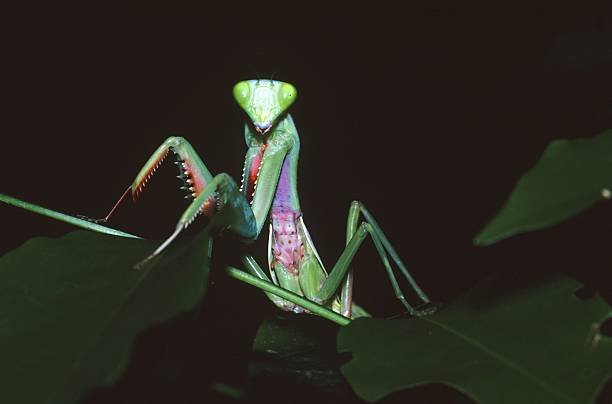Do Praying Mantises Fly?
Do praying mantises fly? as a matter of fact, we would like to know if these bugs even have wings. This weird-looking creature can be kept as a pet and is known to structure itself in a prayer-looking position.
If they have wings do praying mantises fly? well, let us now find out!
Do Praying Mantises Have Wings?

The outer wing and the hind wing are found on the majority of mantises. A leathery outer wing contrasts with a delicate and slender rear one.
Protects and camouflages the hind wings with the outer wing Strong and tough, it’s an extension of the exoskeleton. Mantises employ camouflage to blend in with their surroundings when confronted by predators.
The outer wings of mantises are normally fanned wide when they feel threatened, so they can scare away the predator. The wings of mantises help them appear more powerful and aggressive to their adversaries.
Read also: Facts About the Devil Praying Mantis
Do Praying Mantises Fly?
It’s true that praying mantises can fly, and some of them are particularly skilled at it. Males are better able to fly great distances than females.
In reality, though, praying mantises are creatures that prefer to wait patiently in one place for prey to approach them, rather than go out in search of it.
So, what is it about praying mantises that cause them to soar? As a general rule, flight aids in the acquisition of resources, the dispersal of species, and the avoidance or evasion of predators, as well.
Praying mantises fly in to find a mate so that they can lay their own eggs. In light of this reasoning, it follows that males are more likely to have fully grown wings or the ability to fly. Males are the ones looking for a woman.
When you have the ability to fly, you can explore a larger area in pursuit of a potential spouse. For areas where the species is sparse, this can be very helpful for finding specimens.
It is easier for a male praying mantis to fly, and they can travel further distances because their abdomens are smaller and thinner.
Compared to women, males have a lower body mass to wing size ratio, which indicates that the wings have to lift a smaller weight.
Do All Praying Mantises Fly?
Even though the majority of mantises have wings, this does not necessarily mean that all of them are able to fly. The ability of mantises to fly varies on factors such as species, gender, stage of development, and even weight of the individual bug.
Because they lack wings, some adult species of mantises and young mantises of all species are unable to fly and must instead rely on their ability to leap to migrate from one location to another.
Typically, male praying mantises will go from one location to another via flight. They are able to pick up on the pheromones that the female mantises release when it is time for them to mate.
As soon as the males detect the pheromone, they make their way toward the females in order to mate. Female praying mantises have been observed to consume their mates after mating, which is an example of sexual cannibalism.
Read also: The Budwing Mantis | Fact, Identification & Behavior
Do Praying Mantises Fly Well?
Females are often larger than males, and their wings are typically shorter as well, which limits their ability to fly for longer distances. Young mantises lack wings and are unable to fly as a result. They quickly go from one location to the next.
During the flight, mantises move their heads back and forth and shake their bodies. It is believed that this is an adaptation that allows the animal to land precisely on its intended target.
Mantises are most commonly known as jumping insects. They cover great distances in the blink of an eye thanks to their incredible jumping ability.
They even rotate while in flight to guarantee that they will land precisely where intended.
Do Praying Mantises Fly Fast?
Recent studies have shown that the fastest praying mantises are capable of moving at a speed of 730 millimeters per second.
On the other hand, this amazing speed is more applicable to jumping than it is to flying. The quickest praying mantis is capable of reaching speeds of 730 millimeters per second in its forward motion.
Once the vicious insect has fixed its eyes on a target, it will move its head back and forth, giving the appearance that it is determining the distance from the target as well as its position.
After accurately estimating the distance between themselves and the target, they quickly close the gap by wriggling their bodies back and forth and bending their bellies in order to shift their center of gravity.
At last, they are off the ground. However, just before they touch down, the leafy green predators perform a spinning rotation in the air to ensure that their entire bodies remain aimed in the correct direction.
When they have successfully landed on their target, they use their raptorial legs to seize their victim and then kill it, typically by biting the victim’s head.
Read also: Can Bearded Dragons Eat Praying Mantis?
Conclusion
Your praying mantis will not be able to exercise its flight capabilities so long as it is contained within its enclosure.
Because the distances that it wants to travel or that it is required to travel are not too far, it will simply stroll from one location to another. Mantises do not need to be able to fly in order to be successful hunters.
It will remain still until the prey is in striking distance, at which point it will pounce on it. What do you think of this? let us know via the comments section below.

